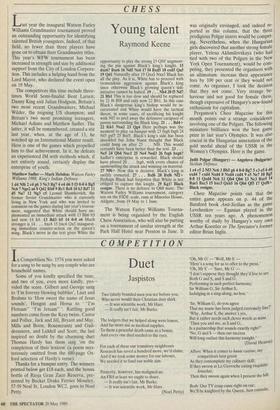CHESS
Young talent
Raymond Keene
Last year the inaugural Watson Farley Williams Grandmaster tournament proved an outstanding opportunity for identifying talented British youngsters. Indeed, of that field, no fewer than three players have gone on to obtain their Grandmaster titles. This year's WFW tournament has been increased in strength and size by additional support from the City of London Corpora- tion. This includes a helping hand from the Lord Mayor, who declared the event open on 19 May.
The competitors this time include three- times World Semi-finalist Bent Larsen; Danny King and Julian Hodgson, Britain's two most recent Grandmasters; Michael Wilder, the reigning US champion; and Britain's two most promising teenagers, Michael Adams and Matthew Sadler. The latter, it will be remembered, created a stir last year, when, at the age of 13, he notched up an International Master result. Here is one of the games which propelled him to that achievement. In it, he defeats an experienced IM with methods which, if not entirely sound, certainly display the enterprise of youth:
Matthew Sadler—Mark Hebden: Watson Farley Williams 1988; King's Indian Defence.
1 d4 Nf6 2 c4 g6 3 Nc3 Bg7 4 e4 d6 5 f3 0-0 6 Bg5 Nc6 7 Nge2 a6 8 Qd2 R68 9 Rcl Re8 10 b3 Bd7 11 d5 Na7 12 Ng3 c5 Leonid Shamkovich, the former Soviet Grandmaster who is currently living in New York and who was invited to comment on the games during last year's tourna- ment, suggested that White should have im- plemented an immediate attack with 13 Bh6 b5 and now 14 h4. 13 Bd3 b5 14 0-0 e6 Much stronger is 14 . . . bxc4 15 bxc4 Qa5 inaugurat- ing immediate counter-action on the queen's wing. Black's move in the text gives White the opportunity to play the strong 15 Qf4! augment- ing the pin against Black's king's knight. 15 dxe6? Bxe6 16 Nd5 Nc6 17 N BxdS 18 exd5 Qa5 19 Qdl Naturally after 19 Qxa5 Nxa5 Black has all the play. As it is, White has to proceed with tremendous aggression against Black's king since otherwise Black's growing queen's side initiative cannot be halted. 19 . . . NM 20 f5 Nd7 21 Bbl This is too slow and should be replaced by 21 f6 Bf8 and only now 22 Bbl. In this case Black's dangerous king's bishop would be in- carcerated and White would have the tactical threat, in some cases, of sacrificing his knight with Nf5 to peel away the defensive carapace of pawns surrounding the Black king. 21 . . . Bd4+ 22 KM Nxa2 23 Qg4 Here perhaps was the moment to play va-banque with 23 fxg6 fxg6 24 Nf5 gxf5 2.5 Bxf5. Black's king's side has been shredded but John Nunn thought that Black could hang on after 25 . . . Nf8. This would certainly have been better than the text. 23 . . . Ne5 24 Qh4 Nxcl 25 Ne4 Ned3 26 fxg6 hxg6? Sadler's enterprise is rewarded. Black should have played 26 . . . fxg6, with every chance of surmounting the attack and winning on material. 27 Nf6+ Now this is decisive. Black's king is swiftly cornered. 27 . . . Bxf6 28 Bxf6 Nf2+ Perhaps Black had forgotten that White is not obliged to capture this knight. 29 Egli Black resigns. There is no defence to Qh8 mate. The Watson Farley Williams tournament, category ten on the FIDE scale, runs at Minories House, Aldgate, from 19 May to 1 June.
The Watson Farley Williams Tourna- ment is being organised by the English Chess Association, who will also be putting on a tournament of similar strength at the Park Hall Hotel near Preston in June. It was originally envisaged, and indeed re- ported in this column, that the three prodigious Polgar sisters would be compet- ing. Nevertheless, when the Hungarian girls discovered that another strong female player, Yelena Akhmilovskaya (who had tied with two of the Polgars in the New York Open Tournament), would be com- peting, they presented the organisers with an ultimatum: increase their appearance fees by 100 per cent or they would not come. As organiser, I took the decision that they not come. Very strange be- haviour and not good for female chess, though expressive of Hungary's new-found enthusiasm for capitalism. Pergamon's Chess Magazine for this month points out a strange coincidence involving one of the Polgars. The following miniature brilliance won the best game prize in last year's Olympics. It was also crucial in the Hungarian annexation of the gold medal ahead of the USSR in the Women's Olympics. Here is the game.
Judit Polgar (Hungary) — Angelova (Bulgaria): Sicilian Defence.
1 e4 c5 2 Nf3 Nc6 3 Bb5 g6 4 0-0 Bg7 5 c3 e5 6 d4 exd4 7 cxd4 Nxd4 8 Nxd4 cxd4 9 e5 Ne7 10 Bg5 0-0 11 Qxd4 Nc6 12 Qh4 Qb6 13 Nc3 BxeS 14 Rael Bxc3 15 bxc3 QxbS 16 Qh6 Qf5 17 QxfS+ Black resigns.
Chess Magazine points out that the entire game appears on p. 44 of the Batsford book Anti-Sicilian as the game Levchenkov — Eganian played in the USSR ten years ago. A phenomenon worthy of study by Hungary's very own Arthur Koestler or The Spectator's former editor Brian Inglis.


































































 Previous page
Previous page